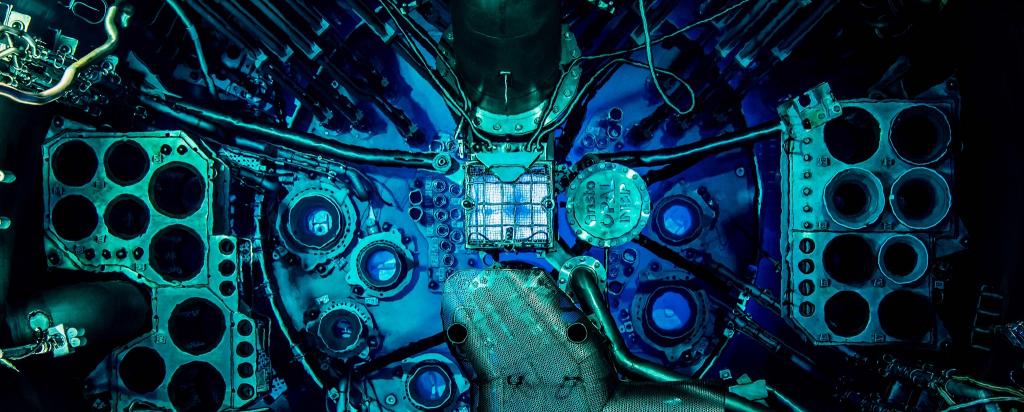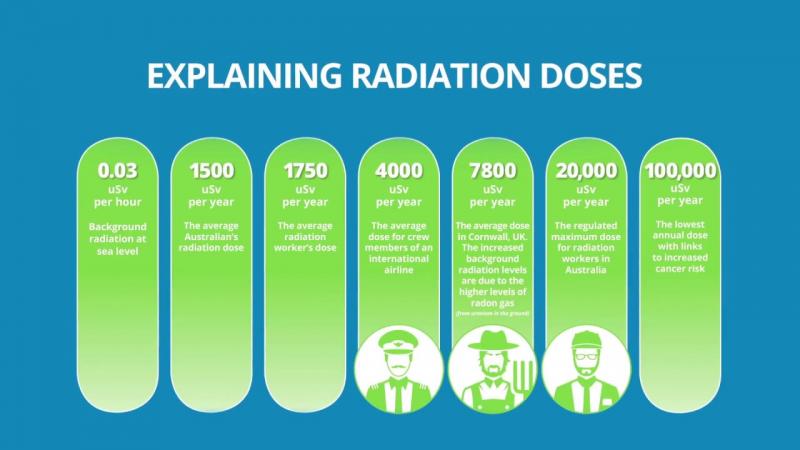

What is radiation?
Radiation
Radiation can be described as energy or particles from a source that travel through space or other mediums. Light, heat, and the microwaves and radio waves used for wireless communications are all forms of radiation.
Radiation includes particles and electromagnetic waves that are emitted by some materials and carry energy. The kind of radiation discussed below is called ionising radiation because it can produce charged particles (or ions) in matter. X-rays, gamma-rays, alpha particles, beta particles and neutrons are all examples of ionising radiation.

Natural background radiation
Australians are constantly exposed to ionising radiation from a variety of natural and artificial sources.
The sun is a major source of cosmic radiation, or radiation originating from space. Airline flights and skiing at high altitudes are activities that will increase exposure to this cosmic radiation. Many buildings also emit ionising radiation simply because the materials that were used to build them, such as clay bricks and granite, are naturally radioactive.

Average exposures to background radiation
- In Australia, people receive about 1,500 to 2,000 μSv of ionising radiation every year. This is the level of natural background radiation in Australia. Low exposure to ionising radiation at this background level is not harmful.
- Australia's level of natural background radiation is quite low compared to many other parts of the world. As a typical example, in the county of Cornwall, UK, people receive about 7,800 μSv of ionising radiation every year. Again, this low level of background radiation is not harmful.
- Passengers on high-altitude flights receive more exposure to cosmic radiation than they would experience at ground level. For example, if you flew return from Sydney to Los Angeles, you would receive an extra 160 μSv of background radiation dose.
- As granite emits more radiation than other materials, a home would granite tiles would exposure the occupants to an extra 1,000 μSv of background radiation annually.
- Some medical X-rays and similar procedures provide radiation doses, with a typical X-ray or CT scan of your head exposing you to 2,600 μSv of ionising radiation.
- Due to its high potassium content, eating a banana will provide you with a dose of 0.1 μSv from the naturally-occurring potassium-40 isotope.
Frequently-asked questions
What is the difference between radiation and radioactivity?
A radioactive atom is unstable because it contains extra energy, or an unbalanced number of particles, in its nucleus. When this atom ‘decays’ to a more stable atom, it releases the extra energy and/or particles as ionising radiation.
How is ionising radiation different from other types of radiation?
Ionising radiation can eject electrons out of atoms (thereby ionising them), either by direct interaction with the atoms or by other methods. Alpha and beta particles, as well as X-rays and gamma rays, are examples of directly-ionising radiation, while neutrons cause ionisation by indirect processes.
Is there more than one kind of ionising radiation?
Yes. In addition to X-rays, three are common. They are called alpha (α),beta (β) and gamma (ɣ) radiation. Alpha particles (helium nuclei consisting of two protons and two neutrons) may be stopped completely by a sheet of paper, beta particles (high-speed electrons) can be stopped by perspex, while gamma rays (like X-rays, but with a shorter wavelength) may need lead or concrete to efficiently stop them - but can be stopped by any material providing there is enough of it. Other less common types of ionising radiation also exist.
Will these ionising radiations make me radioactive?
No. Receiving ionising radiation, such as ultraviolet light from the sun or radiation from a dental/medical X-ray, will not make you radioactive.
If ionising radiation does not make things radioactive, how do items become radioactive in a reactor?
In a reactor there are trillions of free nuclear particles called neutrons. When absorbed by a material they may convert stable isotopes into unstable isotopes and thereby make the material radioactive (i.e. the unstable isotopes will emit their own radiation). This process is how medical radioisotopes are made in the OPAL multipurpose reactor.
Does radiation builds up in the body until it gets to a point where it kills you?
Ionising radiation does not build up in your body any more than light which falls on you builds up in your body. The radiation that reaches you is gone a fraction of a second later.
Radiation effects may appear following exposure to high doses in a short time, such as how a bad dose of sunburn results from too much exposure to sunlight (ultraviolet radiation) too quickly. Similarly, long-term exposure to ionising radiation at high levels may cause permanent damage to the body.
If radiation does not build up within the body, how does it harm a person?
Radiation, including ultraviolet light from the sun, carries energy which may damage living cells by ionising atoms in those cells. If the dose is low, or is delivered over a long time, there is an opportunity for the body cells to repair. Unless the dose is quite high, there is only a miniscule chance that some cells may have been damaged in a way that causes effects, such as cancer, to appear later in life.
National and international dose limits for occupationally-exposed workers and members of the public are many times lower than these high levels. In addition, the goal of radiation protection is to keep long-term environmental exposure, above normal background radiation, to a minimum.
How much does ANSTO’s operations contribute to the radiation doses of nearby residents?
The dose that a member of the community living near ANSTO would receive from our operations is negligible. Those people living close to the bushland perimeter at Lucas Heights (which extends 1.6 km out from the OPAL multipurpose reactor) receive less than 10 μSv per year. This is only 0.7 percent of the average natural background radiation in Australia. People living further away receive proportionately less.
This 10 μSv maximum dose from ANSTO's operations is about the same as the dose received from cosmic rays during a return flight between Sydney and Melbourne, or the dose received from eating two bananas per week for a year.
How are radiation doses measured?
When trying to measure radiation there are two separate aspects to consider: radiation activity, and radiation exposure. Activity refers to how much radiation (in the form of particles or photons) is being emitted by a source, while exposure measures the effects of that radiation on anything that absorbs it.
Radiation activity is measured in an international unit called a Becquerel (Bq), where 1 Bq corresponds to one particle or photon of radiation emitted per second.
Radiation exposure can be measured in three ways:
- Absorbed dose, which is the energy that a radiation source would deposit in one kilogram of a substance. Absorbed dose is measured in an international unit called the Gray (Gy), where 1 Gy corresponds to one joule of energy per kilogram.
- Equivalent dose, which relates the absorbed dose in human tissue to the effective biological damage the radiation causes. Equivalent dose takes into account the fact that different forms of radiation have different biological effects, even when the amount of absorbed dose is the same—some forms of radiation are more damaging than others. Equivalent dose is obtained by multiplying absorbed dose by a radiation weighting factor that corresponds to the type of radiation absorbed. It is measured in a unit called the Sievert (Sv).
- Effective dose, which takes into account that different parts of the body react differently to radiation exposure—some organs are more sensitive to radiation than others. Effective dose is obtained by multiplying equivalent dose by a tissue weighting factor that corresponds to the type of tissue exposed to radiation. If more than one organ is exposed to radiation, then all effective doses to all exposed organs are added together to obtain an overall effective dose. Effective dose is also measured using the Sievert (Sv).
The Sievert is quite a large unit for measuring radiation - a dose of 1 Sv in a short time will cause acute radiation sickness. For describing normal radiation exposure and protection levels it is common to use smaller units such as microSieverts (μSv), or millionths of a Sievert, where 1,000,000 μSv = 1 Sv.
Radiation is often measured as a dose over a specific period of time, known as the dose rate. For example, the typical dose rate from natural background radiation in Australia is 1,500 to 2,000 μSv per year, or equivalently, 4 to 5 μSv per day. The actual exposure received depends on both the dose rate and the exposure time.
What are the safe limits for radiation dose?
Radiographers, workers in the nuclear industry, and radiation workers in general wear a personal dosimeter to record their radiation doses. The National Standard for limiting occupational doses requires that all radiation doses should ‘be kept as low as reasonably achievable’ (ALARA), and that doses received by radiation workers should not exceed 20,000 μSv (about 14 times the average annual natural background level in Australia) to the whole body per year, averaged over five years—and not more than 50,000 μSv in any one year. These dose rates are selected to be well below harmful levels and can be considered safe limits for radiation dose.
The Australian Radiation Protection and Nuclear Safety Agency (ARPANSA) prescribes an annual dose limit for members of the public of 1,000 μSv. This is a dose that may result from the use of ionising radiation but does not include background radiation doses, or dosages you may receive from medical procedures.